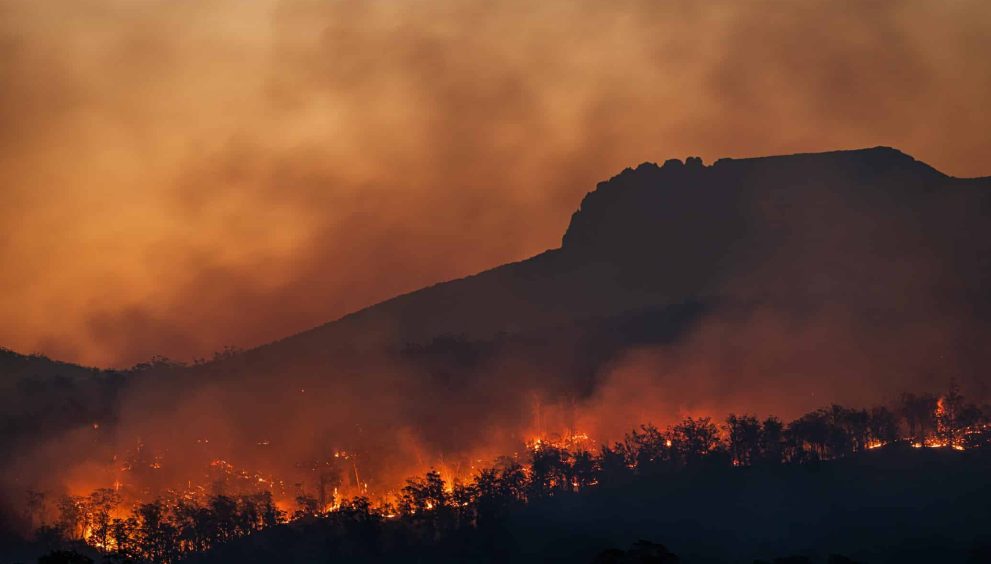Don’t Panic, Prepare: Fireproof Yard Now

Living in Australia means living cheek-by-jowl with the ever-present reality of bushfires. While these blazes are a natural part of the ecosystem, they pose a significant threat to lives, homes, and properties. Thankfully, proactive steps can be taken to fortify your yard and create a resilient buffer zone around your house. This blog equips you with the knowledge and essential actions to bolster your bushfire preparedness and safeguard what matters most.
Think of your yard as a shield between your home and the potential bushfire. Establishing a defendable space of 10-30 metres around your house significantly reduces the fire’s intensity and ember attack risk. Here’s how:
- Reduce fuel load: This is the cornerstone of your efforts. Regularly sweep away dry leaves, twigs, bark, and flammable debris from the ground, gutters, and roof. Mow lawns diligently and trim overgrown vegetation. Remember, every bit of fuel removed is a potential ember extinguished.
- Manage trees and shrubs: Prune low-hanging branches and those reaching close to your house. Thin out dense planting, prioritizing fire-resistant native species. Remove highly flammable trees like conifers and those with loose bark. Consult a qualified arborist for guidance.
- Embrace fire-resistant plants: Replace flammable plants with those that retain moisture, have low sap content, and resist burning. Explore diverse native options like grevilleas, banksias, lomandras, and kangaroo paws. Check out Gardening Australia’s fire-resistant plant list for inspiration: [[invalid URL removed]]([invalid URL removed])
- Maintain a firebreak: Consider creating a gravel or paved path around your house to act as a barrier against flames and embers.
Harden Your Home: Fortifying Your Fortress
While creating a defendable space is crucial, don’t neglect your home itself. Implement these measures to enhance its resilience:
- Gutters and vents: Ensure gutters are clean and debris-free. Install metal mesh over vents to prevent ember entry.
- Windows and doors: Replace standard glass with tempered or fire-resistant glass. Seal gaps around frames and install draught excluders. Consider installing external shutters or roller blinds.
- Roof and cladding: Choose non-combustible roofing materials like metal or tile. Opt for fire-resistant cladding materials where possible.
- External storage: Store flammable materials like firewood and gas bottles well away from the house, ideally in metal sheds.
Stay Informed and Prepared: Knowledge is Power
Bushfire preparedness extends beyond your yard. Be proactive and engage in the following:
- Bushfire Survival Plan: Create a detailed plan outlining evacuation routes, meeting points, and communication strategies for your family. Regularly practice the plan.
- Stay informed: Monitor fire danger ratings and warnings issued by your local authorities. Subscribe to warning systems like FireReady WA or VicEmergency.
- Prepare an emergency kit: Pack essential items like food, water, first-aid supplies, medications, important documents, and a battery-powered radio.
Remember, fireproof isn’t a guarantee, but it significantly increases your chances of surviving a bushfire. By following these steps and staying informed, you can significantly enhance your yard’s resilience and protect your loved ones.
Additional Resources:
- Bushfire Ready Australia
- CSIRO Bushfire and Natural Hazards
- Bureau of Meteorology Fire Danger Ratings
Together, we can create safer communities and face the bushfire challenge head-on.
Fireproof Your Yard: Beyond the Basics (Part 2)
In Part 1, we explored creating a defendable space and hardening your home for bushfire protection. Now, let’s delve deeper into advanced strategies and ongoing maintenance practices to further fortify your yard and ensure your preparedness is top-notch.
Firefringe Management: Taming the Edges
The firefringe is the boundary between your defendable space and the surrounding landscape. Here’s how to manage it effectively:
- Slashing and mulching: Regularly slash and mulch vegetation beyond your mowed lawn area. This reduces fuel load and creates a fuel-reduced zone that slows fire spread.
- Fire trails and access tracks: Consider creating fire trails or wider access tracks around your property for easier fire truck access and potential escape routes. Ensure they are clear of debris and well-maintained.
- Natural firebreaks: Utilize natural features like creeks, rock outcrops, and firebreaks created by previous burns to your advantage. Furthermore, consider strategically planting fire-resistant vegetation along these natural barriers.
Water Wise: Your Liquid Ally
Having a readily available water source is crucial for fire suppression and protecting your home. Consider these options:
- Tanks and pumps: Install water tanks with sufficient capacity (ideally, 5,000-10,000 litres) and invest in a firefighting pump for direct application.
- Sprinkler systems: Explore fixed sprinkler systems around your house and defendable space for automated fire suppression. Additionally, consider connecting them to your water tanks for independent operation.
- Swimming pools and dams: Strategically positioned swimming pools or dams can serve as water sources, but ensure they are accessible and have adequate water volume. However, remember they may not be suitable for primary firefighting due to limited volume or potential contamination.
Ongoing Maintenance: Vigilance is Key
Bushfire preparedness is an ongoing process, not a one-time effort. Here are maintenance practices to remember:
- Regular inspections: Conduct regular inspections of your yard, roof, gutters, and vents, removing any accumulated debris. Furthermore, check for any damage or potential fire hazards that need addressing.
- Seasonal maintenance: Adapt your maintenance routine to the season. In summer and autumn, increase vigilance and clear debris more frequently. Additionally, consider creating firebreaks when vegetation is dry and flammable.
- Stay informed: Keep abreast of changes in fire regulations and best practices by consulting with local authorities and fire agencies. Moreover, attend community workshops or training sessions to stay updated on the latest fire safety information.
Working Together: Community Strength
Remember, bushfire preparedness isn’t just an individual responsibility. Community collaboration is crucial. Here’s how you can contribute:
- Join a local bushfire brigade: Volunteering with your local brigade strengthens community preparedness and provides valuable support during emergencies. Furthermore, it allows you to gain valuable skills and knowledge about fire safety and suppression.
- Communicate with neighbours: Discuss shared fire risks, evacuation plans, and potential assistance you can offer each other. Additionally, organize neighbourhood meetings or fire drills to practice your plans and foster collaboration.
- Support fire prevention initiatives: Advocate for and participate in local fire prevention programs and controlled burns that can reduce overall fire risk. Moreover, spread awareness about fire safety measures within your community.
By implementing these advanced strategies, maintaining your efforts, and collaborating with your community, you can significantly enhance your yard’s fire resistance and create a safer environment for yourself, your loved ones, and your community. Remember, every action you take, big or small, contributes to a more fire-resilient Australia.
Together, we can make a difference.
Additional Resources:
- MyFireWatch
- Australian Fire Authorities Council
- National Bushfire Information Hotline: 1800 240 667
I hope this continuation provides even more valuable insights and actionable steps for fireproofing your yard. Stay safe and prepared!












